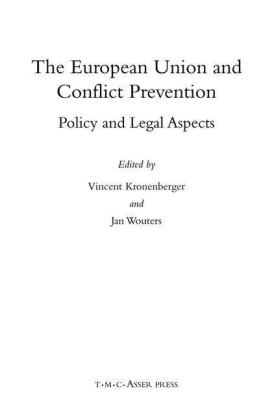Read more
Informationen zum Autor V. Kronenberger! legal secretary! Court of First Instance of the EC! Luxembourg. Jan Wouters! Professor of International Law! Catholic University of Leuven. Klappentext Since 2001, the prevention of violent conflicts has been a priority of the European Union's external policy. In addition to new operational competences developed under the Common Foreign and Security Policy, the European Union is particularly suited to combat root-causes of conflicts throughout the world. The current draft Constitution for Europe proposes to insert the prevention of conflicts within the text of the Treaty. This volume explores and scrutinizes the progress achieved by the European Union in the definition of a concrete conflict prevention strategy, as well as the challenges it still faces. The contributors focus on the following issues: definition of and indicators for conflict prevention; institutional and constitutional dimension of conflict prevention; EU's instruments for the prevention of violent conflicts; structural conflict prevention and mainstreaming conflict prevention into EU's policies; and cooperation with other international organisations and civil society. Zusammenfassung Since 2001, the prevention of violent conflicts has turned into a priority of the European Union's external policy. In addition to new operational competences developed under the Common Foreign and Security Policy, the European Union is particularly suited to combating the root causes of conflicts spreading throughout the world. It is noteworthy that the Treaty establishing a Constitution for Europe, signed in Rome on 29 October 2004, proposes to insert the prevention of conflicts in the Constitution. In 25 original essays written by both practitioners and scholars from European institutions, international organisations, universities and NGOs, this book proposes to explore and scrutinize the progress achieved by the European Union in the definition of a concrete conflict prevention strategy, as well as the challenges it still faces. In particular, the book dwells on the following issues: the definition of and indicators for conflict prevention; institutional and financial dimensions of conflict prevention; EU instruments for the prevention of violent conflicts; structural conflict prevention and the mainstreaming of conflict prevention into EU policies;and cooperation with other international organisations and other actors, such as NGOs and the private sector. Inhaltsverzeichnis Indicators to Prevent Conflicts: The Practice of Eu Institutions.- Conflict Indicators Developed by the Commission — The Check-List for Root Causes of Conflict/Early Warning Indicators.- The Council’s Early Warning Process.- EU conflict prevention strategy and practice so far.- The Eu and Conflict Prevention: A Brief Historic Overview.- The Eu’s Involvement in Conflict Prevention — Strategy and Practice.- Eu Instruments for Conflict Prevention.- The Institutional and Financial Dimensions of Conflict Prevention.- EU conflict prevention strategy and practice so far.- Eu Structural Foreign Policy And Structural Conflict Prevention1.- Eu Regional Trade Agreements’ Role in the Prevention of Conflict and in Increasing (Intra-Regional and Global) Security and Stability: An Economic Perspective.- Community Cooperation Policy and Conflict Prevention.- Environmental Policy and Conflict Prevention.- Conflict Prevention and Human Rights.- The Prevention of Conflicts and Combating Trafficking (Humans, Drugs, Firearms, Weapons ...) and Terrorism.- Pulling Up Conflicts by the Roots: Towards a Conflict Prevention Assessment of EU Policies.- EU conflict prevention strategy and practice so far.- Eu Conflict Prevention in the Western Balkans.- Strategies of Conflict Prevention for Sub-Saharan Africa.- Experience of other a...

